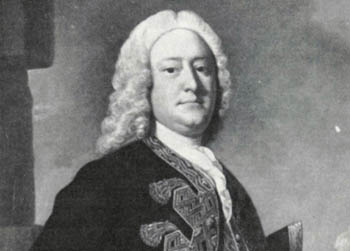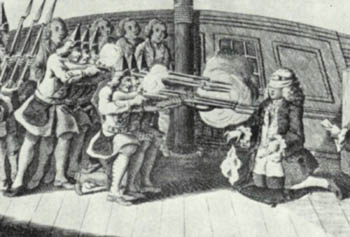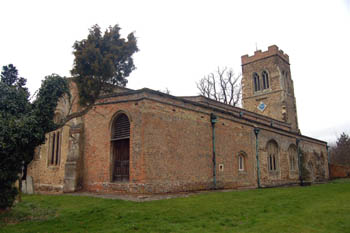
Admiral Byng by Thomas Hudson
In Southill churchyard is the Byng family vault. A tablet in the vault states with some boldness:
To the perpetual Disgrace of
Public Justice
The Honourable John Byng
Admiral of the Blue
Fell a Martyr to
Political Persecution
On March 14, in the Year 1757;
When Bravery and Loyalty
Were insufficient Securities
For the Life and Honour
Of a Naval Officer
John Byng was born at Wrotham Park, Southill in 1704, fourth son of Admiral George Byng, Viscount Torrington (1663-1733), hero of the Battle of Cape Passaro in 1718 in which he destroyed the Spanish fleet. John entered the navy in that same year and rose to command a frigate in the Mediterranean in 1727. He became a Rear Admiral in 1745 and in 1756 was sent to prevent the French (this was the opening year of the Seven Years War) taking the Balearic island of Minorca.

La Galissonniere by Graincourt
Unfortunately he was not the man his father had been. Many of his ships were short of men and he seems to have persuaded himself that if he met the French he would lose. He duly met the French and duly lost - defeated by the French Admiral le Marquis de la Galisonniere off Port Mahon on 20th May.
Byng proved he was not a gifted admiral by attacking the French in a particularly clumsy way, his leading ships being exposed to French fire before the bulk of his force could get into cannon range. Having mauled the lead ships the French then withdrew, content at their partial victory. Byng was urged to manoeuvre so that he could bring all his guns to bear on the withdrawing French but he declined to do so and de la Galisonniere's fleet escaped without damage.

Byng's execution - from the London Magazine
Byng then tarried near Minorca for four days without making any attempt to bring the French to battle then sailed back to Gibraltar, leaving the garrison of Minorca to its fate and it duly fell to the French on 29th June. For Byng's actions he was brought before a court martial on his arrival back in England. He was charged with cowardice and disaffection (of which he was cleared) and with having not done his utmost to follow the orders given him - of this he was convicted. He was then shot on the quarterdeck of HMS Monarch off Spithead on 14th March 1757 by six Royal Marines as he knelt with a handkerchief over his eyes.

Southill church from the north-east, showing the Byng family vault, March 2008
His execution caused a political uproar and the execution was seen as a kind of judicial murder - a book written by Dudley Pope in 1962 - At Twelve Mr.Byng Was Shot certainly takes this line and may be read in the Bedfordshire & Luton Archives & Records Service searchroom. Nevertheless the execution may have had the effect of instilling a high level of aggression in senior British naval officers. The French novelist Voltaire satirised the event in his Candide published in 1759. On witnessing the execution of a fat man on board a ship the character asks what was going on and was told that in Britain it was felt wise to execute an admiral from time to time to encourage the others - "pour encourager les autres"